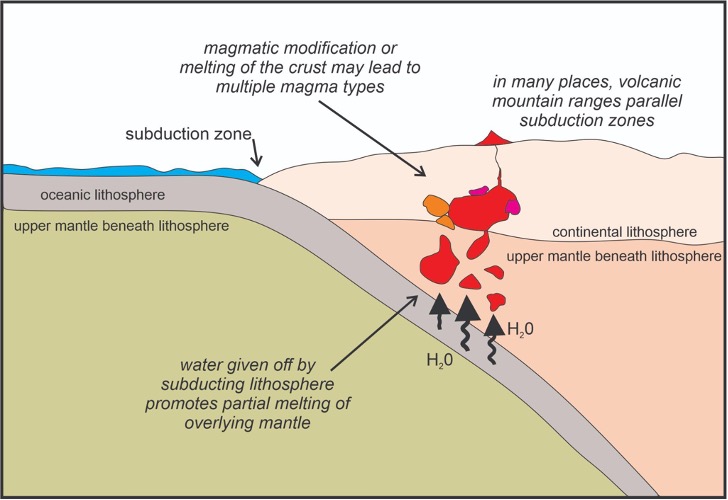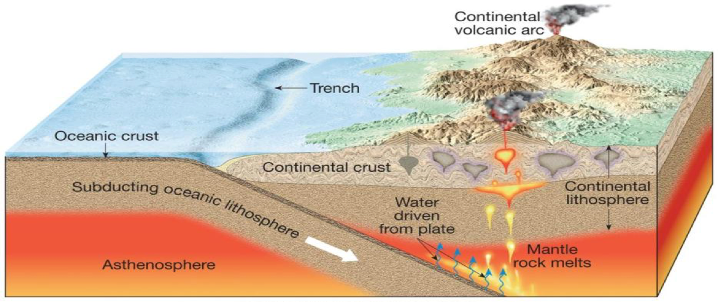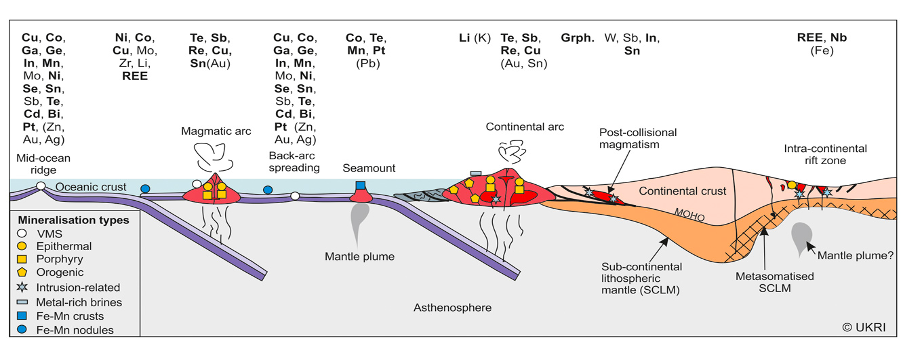“Plate tectonics is part of the water cycle”
Excuse me…did you say that plate tectonics is part of the water cycle?
Yes, I did…..read on and let me explain how, and also why it should and could be incorporated into your geography teaching. This is not as tricky as you might think; it will just be unfamiliar to most geography teachers as it is not ‘standard’ in textbooks, although as argued here, it should be. The parallel is teaching about the carbon cycle – although by analogy rather than exact processes.
Watch this (2 minutes 20)
Teaching about the carbon cycle incorporates the deep (very) long-term carbon cycle – i.e. how carbon gets locked up as ‘fossil carbon’ limestone and fossil fuels (oil, coal and gas), as part of the rock cycle. These forms of carbon spend millions of years (can be hundreds of millions) deep in the lithosphere. In the natural system fossil carbon is returned slowly to the atmosphere when the geological lithosphere is uplifted and the rocks are eroded.
In the parallel of the water cycle (sea) water is caught up in rocks of the oceanic lithosphere (plate) formed at mid-ocean ridges ands most of it is incorporated into the minerals of the rock rather than ‘swilling around’, although a small proportion is found in numerous cracks and fractures in the plate. The oceanic rocks are eventually subducted, and when they are somewhere between 90 and 140 km deep the minerals dehydrate (due to the pressure) and the water is driven off into the overlying wedge of mantle (above the subducting plate slab).
Adding water into mantle rocks (called peridotite) will melt it at a lower temperature, because the bonds in the minerals that make up the rock are disrupted by the water molecules (melting ice by adding salt is a similar process – known as ‘flux melting’). Typically only about 10% is melted, generating partial melting and big ‘pockets’ magma in the mantle wedge.

Image source: Dexter Perkins Open Petrology textbook Chapter 3 Magma, Melting, and Crystallization https://opengeology.org/petrology/03-magma/
Click here to show an animation of how this works in 3D
The ‘wet’ magma is very sticky (more like treacle than water) and rises slowly through the mantle wedge (because it is lighter) rather like the blobs in a lava lamp, eventually reaching the lithosphere of the overlying plate. As it ascends the temperature of the magma rises and the upward flow of magma may bulldoze its way through overlying lithospheric rock. Some of this melt is halted in the lithosphere where it slowly cools to form granite plutons. Other pockets of melt ascend as ‘diapirs’ and pond in an igneous plumbing network of magma chambers below the surface. When the pressure builds in the plumbing magma can break through and erupt onto the Earth’s surface. The longer the ascending magma has to travel through the lithosphere, the stickier it becomes. And the stickier the lava, the more explosive and violent the eruption on the surface!

Image source: USGS, Public Domain.

Image source: Trista L. Thornberry-Ehrlich, Colorado State University https://npgallery.nps.gov/AssetDetail/8647891c-ed6c-4d8b-9eb9-83bbfe9a5c28
And one more very important thing about the deep water cycle…it is fundamental to today’s digital civilisation…not because we use the water of the deep water cycle directly, but because it is the key process in the formation of critical minerals.
The ‘wet’ magma of plutons cooling deep in the continental lithosphere generates hot hydrofluids which contain dissolved minerals such as gold, copper, tin and other critical minerals such as Antinomy, Tellerium and Rhenium. These mineral resources are vital for today’s technologies. The fluids penetrate deep cracks in the lithosphere above the pluton and cool to form valuable hydrothermal mineral deposits. This wouldn’t happen if the deep water cycle didn’t happen!

Image source: https://www.bgs.ac.uk/geology-projects/critical-raw-materials/
The ‘deep water cycle’ model explains several things:
- why a chain of volcanoes, or a volcanic island arc, develops on the over-riding plate of a convergent plate margin parallel to an ocean trench plate boundary;
- why the degree of explosiveness of a volcanic eruption is related to the type of convergent plate margin; explosive at oceanic – oceanic margins; and very explosive at ocean-continent margins).
- why mineral resources, that are vitally important to today’s digital world, are concentrated in certain places, and how new discoveries of these mineral deposits might be predicted.
Try incorporating the deep water cycle in your teaching….it could be part of a teaching unit on the water cycle, or part of lessons on plate tectonics, or incorporated into lessons on sustainability and raw materials resources. Or even better, teach in one of these topics and re-visit and link to the other topics…..your students will definitely benefit and learn more about the Earth on which they live!

Leave a Reply